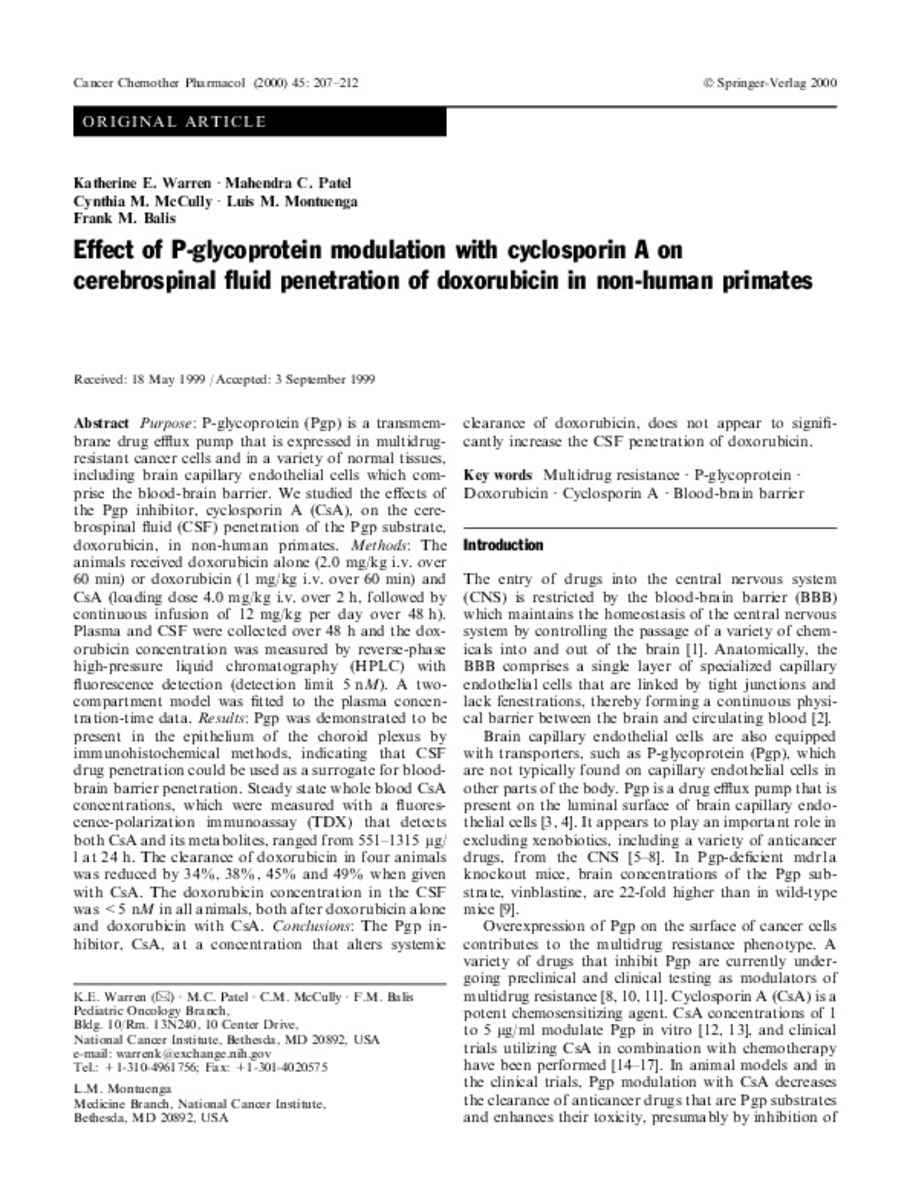Full metadata record
| DC Field | Value | Language |
|---|---|---|
| dc.creator | Warren, K.E. (Katherine E.) | - |
| dc.creator | Patel, M.C. (Mahendra C.) | - |
| dc.creator | McCully, C.M. (Cynthia M.) | - |
| dc.creator | Montuenga-Badia, L.M. (Luis M.) | - |
| dc.creator | Balis, F.M. (Frank M.) | - |
| dc.date.accessioned | 2011-12-12T08:41:05Z | - |
| dc.date.available | 2011-12-12T08:41:05Z | - |
| dc.date.issued | 2000 | - |
| dc.identifier.citation | Warren KE, Patel MC, McCully CM, Montuenga LM, Balis FM. Effect of P-glycoprotein modulation with cyclosporin A on cerebrospinal fluid penetration of doxorubicin in non-human primates. Cancer Chemother Pharmacol 2000;45(3):207-212. | es_ES |
| dc.identifier.issn | 1432-0843 | - |
| dc.identifier.uri | https://hdl.handle.net/10171/20174 | - |
| dc.description.abstract | PURPOSE: P-glycoprotein (Pgp) is a transmembrane drug efflux pump that is expressed in multidrug-resistant cancer cells and in a variety of normal tissues, including brain capillary endothelial cells which comprise the blood-brain barrier. We studied the effects of the Pgp inhibitor, cyclosporin A (CsA), on the cerebrospinal fluid (CSF) penetration of the Pgp substrate, doxorubicin, in non-human primates. METHODS: The animals received doxorubicin alone (2.0 mg/kg i.v. over 60 min) or doxorubicin (1 mg/kg i.v. over 60 min) and CsA (loading dose 4.0 mg/kg i.v. over 2 h, followed by continuous infusion of 12 mg/kg per day over 48 h). Plasma and CSF were collected over 48 h and the doxorubicin concentration was measured by reverse-phase high-pressure liquid chromatography (HPLC) with fluorescence detection (detection limit 5 nM). A two-compartment model was fitted to the plasma concentration-time data. RESULTS: Pgp was demonstrated to be present in the epithelium of the choroid plexus by immunohistochemical methods, indicating that CSF drug penetration could be used as a surrogate for blood-brain barrier penetration. Steady state whole blood CsA concentrations, which were measured with a fluorescence-polarization immunoassay (TDX) that detects both CsA and its metabolites, ranged from 551-1315 microg/l at 24 h. The clearance of doxorubicin in four animals was reduced by 34%, 38%, 45% and 49% when given with CsA. The doxorubicin concentration in the CSF was <5 nM in all animals, both after doxorubicin alone and doxorubicin with CsA. CONCLUSIONS: The Pgp inhibitor, CsA, at a concentration that alters systemic clearance of doxorubicin, does not appear to significantly increase the CSF penetration of doxorubicin. | es_ES |
| dc.language.iso | eng | es_ES |
| dc.publisher | Springer Verlag | es_ES |
| dc.rights | info:eu-repo/semantics/openAccess | es_ES |
| dc.subject | Multidrug resistance | es_ES |
| dc.subject | P-glycoprotein | es_ES |
| dc.subject | Doxorubicin | es_ES |
| dc.subject | Cyclosporin A | es_ES |
| dc.subject | Blood-brain barrier | es_ES |
| dc.title | Effect of P-glycoprotein modulation with cyclosporin A on cerebrospinal fluid penetration of doxorubicin in non-human primates | es_ES |
| dc.type | info:eu-repo/semantics/article | es_ES |
| dc.relation.publisherversion | http://www.springerlink.com/content/yc56xpnt3w7v9a7p/ | es_ES |
| dc.type.driver | info:eu-repo/semantics/article | es_ES |
Files in This Item:
Statistics and impact
Items in Dadun are protected by copyright, with all rights reserved, unless otherwise indicated.






